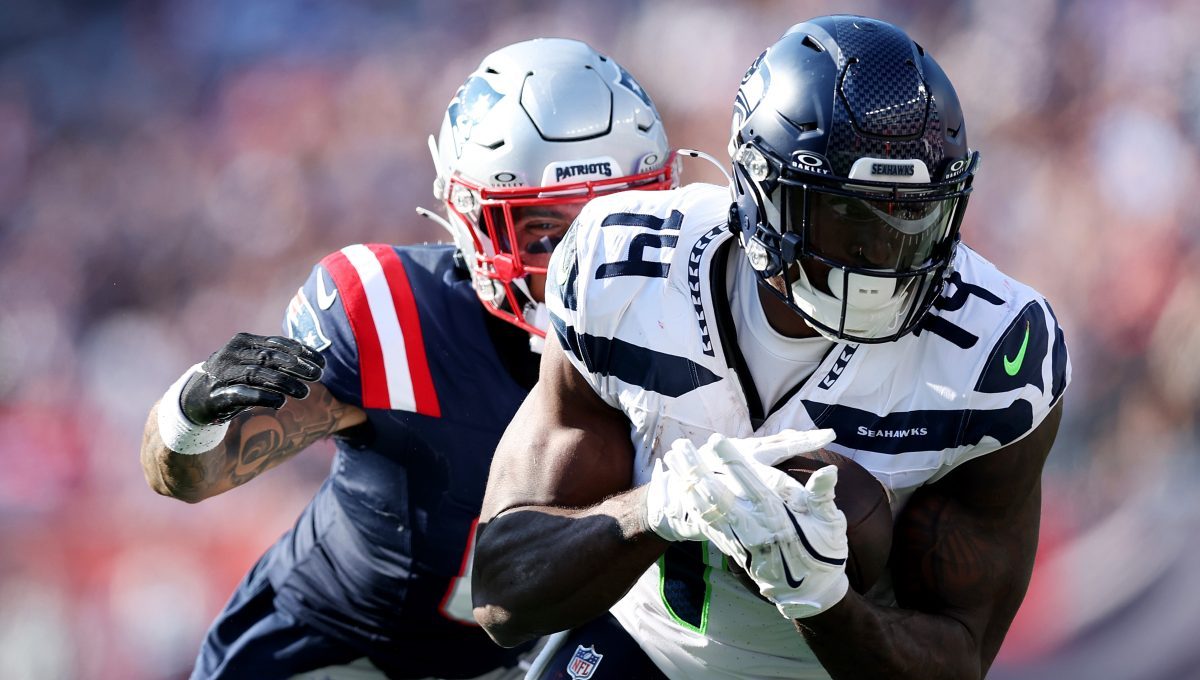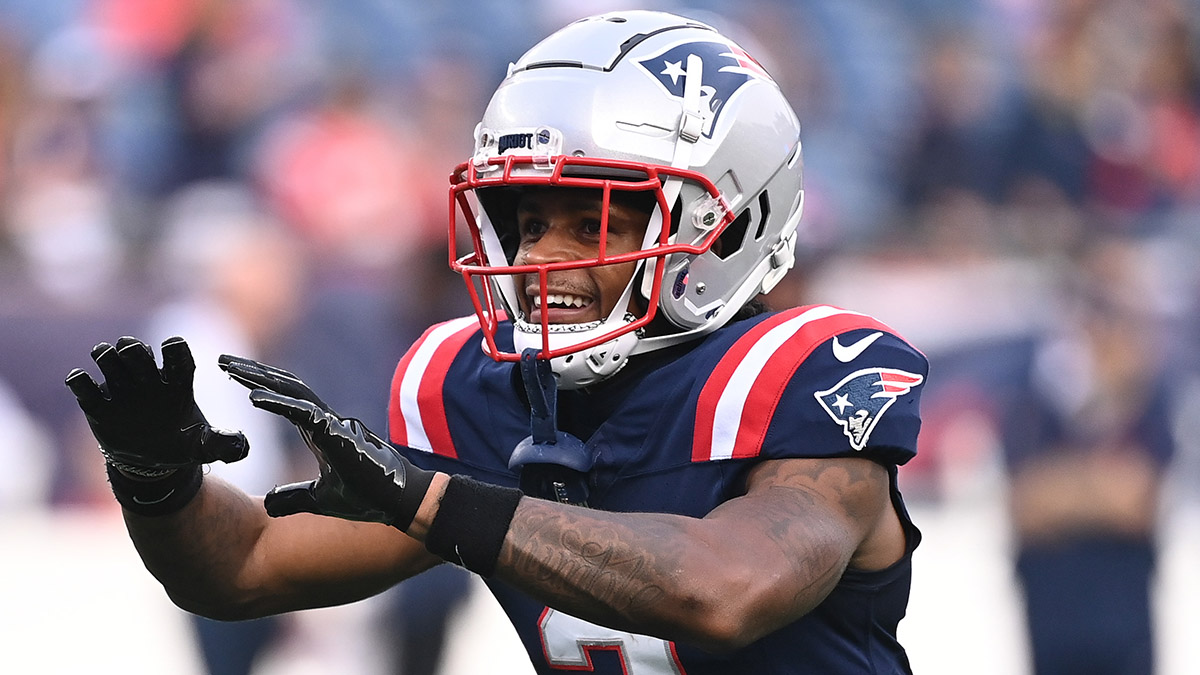FOXBORO -- Each and every week, we'll be highlighting a variety of the lessons gathered from the latest Patriots matchup. Of course, there was no shortage of teaching moments in Sunday's overtime loss to the Seahawks.
Here's what we learned from Week 2...
Protection issues are here to stay
Stay in the game with the latest updates on your beloved Boston sports teams! Sign up here for our All Access Daily newsletter.
Jacoby Brissett was a magician Sunday. He was pressured on 13 of his dropbacks to give the Patriots a pressure rate of over 40 percent over the course of the last two weeks. He was sacked three times, but that number would have been much higher if not for some deft pocket movement by the veteran signal-caller.
It's just not sustainable. When sacked by Leonard Williams in the third quarter on third-and-10, Brissett appeared to tweak his foot or ankle under Williams' weight. He also seemed to have his helmet bounce off the turf with his arms pinned to his side. Later in the game he absorbed a hit to his ribs and was dropped on his left shoulder on an incompletion.
Vederian Lowe allowed a sack, a hit and three pressures and was banged up at the end of the game before giving way to rookie tackle Caedan Wallace. Mike Onwenu allowed a hit and what looked like four pressures. Layden Robinson was on the scene for a sack, as was Michael Jordan.
Brissett now has the second-highest pressure rate in the NFL through two weeks (44.3 percent), which trails only Tennessee's Will Levis (53.4). Yet Brissett is 12th in EPA per dropback among passers who've played two games (-0.05), and he's 10th in success rate.
The fact that Brissett has been able to mitigate his sack total with the amount of pressure he's seen has been eye-opening. But given some of the shots he took Sunday, the Patriots aren't going to benefit long from his slipperiness in the pocket for long. New England's linemen aren't getting any healthier, and neither is their quarterback.
Until or unless Alex Van Pelt can scheme up more quick-hitting strikes in the passing game -- Brissett's average time to throw (3.11 seconds) is third-longest in the NFL -- the pass protection problem will persist.
Time to mix it up at receiver
The Patriots completed only three passes to receivers on Sunday, including two catches from Ja'Lynn Polk for 12 yards and his first NFL touchdown. DeMario Douglas wasn't targeted, nor was Tyquan Thornton. It was as though the team conceded matchups on the outside to talented Seahawks corners Tariq Woolen and Devon Witherspoon.
The team's lone attempt through the air that traveled more than 20 yards was a wheel route incompletion to Rhamondre Stevenson. While the Patriots were successful at times running the football Sunday, they still faced eight defenders in the box on a regular basis -- one third of Stevenson's carries and 36.4 percent of Gibson's came against loaded boxes -- and they weren't able to take advantage through the air.
They can't continue to play that way, and Jerod Mayo knows it.
"We definitely have to start to get the ball down the field," he said after the game.
Might be time to experiment.
Without much in the way of substitution options on the offensive line, the Patriots may want to see if a younger contingent of wideouts can provide them more juice. Javon Baker was active and played six snaps but was on the field for just one pass play. Kayshon Boutte was inactive due in part to his lack of a role in the kicking game. But it's my understanding that the Patriots remain encouraged by both given what they've shown in practice.
If the team wants to shake things up in that room to see if there's any more production there to be had, then going younger could be an option. K.J. Osborn and Tyquan Thornton have combined for six catches for 55 yards in two games.
MORE PATRIOTS COVERAGE
Dugger misread proves costly
When the Seahawks aligned in an empty formation with Geno Smith in the shotgun, the veteran quarterback made a subtle hand signal to his teammates like he was pushing something down by his knee.
The Patriots, on the other side, began to signal to each other by pressing up over their heads. The cat-and-mouse game was on.
Kyle Dugger and his teammates had checked into a "max blitz." The Seahawks, though, had an answer. The result was a 56-yard wide-open touchdown strike to DK Metcalf. And Dugger owned it.
DK Metcalf WIDE OPEN for a 56-yard TD!
— NFL (@NFL) September 15, 2024
📺: #SEAvsNE on FOX
📱: https://t.co/waVpO909ge pic.twitter.com/nLjzMeiUub
"We were in max blitz coverage," Dugger said later. "Just a bad read by myself. They caught us in a call that was kind of problematic, their offensive call versus our defensive call."
Dugger added: "You just have to read the quarterback. I didn't get a good read on the quarterback so that's basically like a bust."
Metcalf split both Dugger and corner Christian Gonzalez -- who eneded up tracking Metcalf throughout the game -- for his explosive game-tying score. Dugger had his eyes in the backfield, apparently waiting for a shorter throw with his blitzing teammates getting into the backfield quickly. Didn't happen. Coming from off the line, Jahlani Tavai got into the rush perhaps a beat late, and Smith had time to launch.
"Max coverage," Dugger said. "Not really a true man-to-man (play). They caught us. I checked the play to max blitz. Probably shouldn't have, obviously. Hindsight is 20-20. But yeah. We checked it after they checked it. That's just kind of part of the gameplan."
Patriots looking for a fourth CB
How the Patriots deployed their cornerbacks on Seattle's second touchdown drive of the game was curious.
Jonathan Jones, one of their most dependable defensive backs, was deep into the sideline when the series began. He wasn't injured. But he clearly wasn't planning on playing, either. Instead, Marco Wilson was on the field.
The Seahawks tooks advantage. They ran a pick play on third down to Wilson's side -- with Marcus Jones getting picked -- that led to a conversion. They later targeted Wilson in the end zone on third down, drawing a pass-interference penalty that led to a goal-line score.
Why was Wilson in the game and not Jones? Part of the plan for New England.
I was told after the game that the occasional swap was a way to help preserve Jones' health, as he's been banged up at times in recent seasons. He missed three games injured last year.
🔊 Patriots Talk Podcast: The Aftermath: Little mistakes cost Patriots big in loss to Seahawks | Listen & Subscribe | Watch on YouTube
But perhaps more importantly, the team feels it needs to get a fourth corner significant playing time at this point in the year in order to have that player ready to go later in the season if an emergency arises. Wilson has been the choice thus far, playing 29 total snaps in two games.
"It means a lot," Wilson told me after the game. "I knew coming into this squad they had their guys who had been solidified here. I knew that I would have to be fighting even to see the field. It means a lot. It means a lot to even see the field and that they trust me and trust in my ability to be out there."
As for his penalty, his second defensive pass interference in as many games? He disagreed. (There's always something you can do better," he said after the game, "even though it was a perfect rep in my eyes.") But he knows he needs to play penalty-free to keep getting looks.
"Second penalty in a week, that's inexcusable for me," he said. "That's something that I'll work out of my game. But it means a lot to get reps. That's something, as a football player, especially as a corner, you need reps. It's hard to perform in this league without reps."
Change could be in order after FG block
Asked if there was a general rule of thumb when having to try to stop two rushers on a field-goal attempt, Austin Hooper said plainly, "Yeah, don't let them block it."
Hooper was given the difficult task of having to try to stop two of Seattle's best defensive backs, who had been deployed on his side to block a potential game-winning field goal for New England. Both Woolen and Julian Love aligned on the left side of the Patriots' alignment, both attacking Hooper at the snap.
Love ended up breaking through and deflecting Slye's attempt late in the fourth quarter to keep the score at 20-17 in favor of New England.
BLOCKED BY J LOVE! pic.twitter.com/ej3rNNUFG6
— Seattle Seahawks (@Seahawks) September 15, 2024
"I was just punching," Hooper said, "turned around and heard something and was like, 'What just happened?' "
Hooper added: "You gotta try to take two-for-(one) if you can... I gotta be better. Not just to notice the overload but to communicate more effectively with everyone knowing that's their No. 1 rush. That's their fastball out there. Their two fastest guys who've blocked kicks in this league before."
Though Love, as the rusher inside, had the quicker path to kicker Joey Slye, it seemed like Woolen's speed had Hooper's attention.
"Guy runs a 4.2 (-second 40-yard dash), he's the widest," Hooper said. "I'm on the wing, I'm thinking this guy is a 4.2 guy who can bend really well. I'm thinking, 'All right, let's punch him in his chest.'"
How will special teams coach Jeremy Springer see that play? Could Michael Jordan, playing next to Hooper, have given Love some resistance to save it? Or do the Patriots need a longer-armed option on the wing to prevent against further miscues?
Deatrich Wise has held that job before and may deserve a look. Odds are that others will test the Patriots in the coming weeks to ensure they've fixed the leak.



